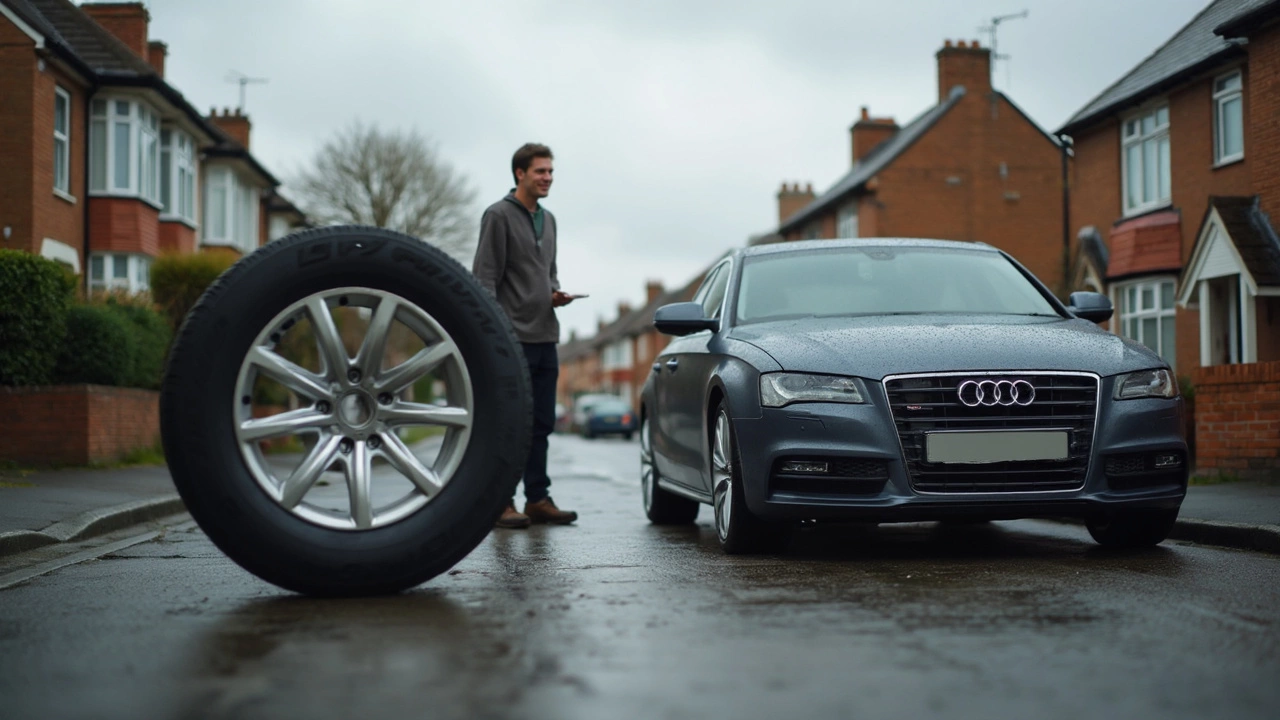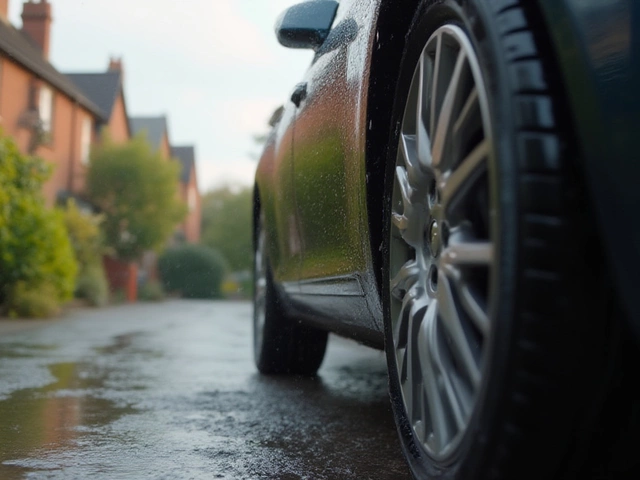Most people think upgrading to bigger alloy wheels instantly makes their car look sharper. But when it comes to comfort, size really does matter—and not always the way you expect. Before you rush to grab those flashy 20-inch alloys, it's worth thinking about how wheel size changes your car’s feel on real roads.
Wheel size directly affects how bumpy or smooth your ride will be. Pick a wheel that's too big, slap on tiny-profile tires, and you'll notice every pothole like it's a personal insult. Go too small, and maybe your steering feels dull. So, when someone asks what size wheels are most comfortable, there's no one-size-fits-all answer. It depends on your car, your local roads, and how much you care about style versus those annoying rattles.
If you want a rule of thumb, most cars feel the comfiest with wheels that are one or two inches bigger than the factory steelies, but not much more. Stick within that sweet spot, and you usually keep comfort without losing the “wow” factor. But there’s more to it—let’s dig in.
- Why Wheel Size Changes How Your Car Feels
- Big vs Small: The Comfort Showdown
- Unexpected Factors That Matter
- Choosing the Right Wheel Size for Your Life
Why Wheel Size Changes How Your Car Feels
The size of your wheels does more than just change up your car’s look—it completely tweaks how your ride feels and reacts on the road. Swapping out your factory wheels for those bigger or smaller alloy wheels really shakes up the balance between comfort, handling, and even fuel efficiency. But how does this actually happen?
It mainly comes down to two things: the diameter of the wheel and the height of the tire sidewall (that’s the cushion between your rim and the road). With bigger wheels, you usually have to use low-profile tires—basically, tires with a thinner layer of rubber. That means less “give” when you hit bumps or potholes. Smaller wheels let you run chunkier tires, which soak up rough roads a lot better.
If you’re wondering how different options compare, check out this simple breakdown:
| Wheel Size | Typical Tire Profile | Ride Comfort | Handling |
|---|---|---|---|
| 15"-16" | Tall (thicker sidewall) | Softer, smoother | Basic, not super sharp |
| 17"-18" | Medium | Good mix | Sportier, but still comfy |
| 19"-20" | Low profile | Firmer, every bump is felt | Tighter, more direct feel |
This isn’t just guesswork. Car testers have actually measured cabin vibration levels with different wheel sizes. One popular midsize sedan, for example, was up to 15% harsher on rough roads with 19-inch wheels versus 17-inch wheels. That’s the kind of difference you’ll notice on daily commutes.
If you want a smooth drive, focus on the combination of wheel and tire. Here’s what actually changes when you mess with sizing:
- alloy wheels that are bigger usually mean thinner tires, so comfort drops.
- Smaller wheels allow for taller tires, so bumps get absorbed better.
- Bigger wheels usually add weight, which makes your car feel stiffer and sometimes less zippy.
- Low-profile tires (needed with big wheels) are more prone to damage from potholes.
The sweet spot depends on your car and what kind of roads you drive on most. That’s why it pays to really think about wheel size, not just pick what looks good in a photo.
Big vs Small: The Comfort Showdown
Here’s the deal—wheel size changes the way your car rides, sometimes in good ways, sometimes not so good. When people swap to bigger alloy wheels, they usually do it for looks or sharper handling. But that upgrade comes with a tradeoff: less cushion between you and every bump in the street.
The main reason? Bigger wheels mean lower-profile tires, which have less rubber between the rim and the road. That thin strip of tire doesn’t soak up potholes or cracks the way chunkier tires do. Your car starts to “feel” the road a lot more, and not always in a good way if comfort is what you want.
- Alloy wheels that are 18 inches or bigger often make the ride stiffer, especially on small cars or crossovers. Sedan drivers who go from 16-inch to 19-inch wheels sometimes report a 10-15% harsher ride, based on test data from several auto magazines.
- On the other hand, smaller wheels (15-16 inches on most cars) usually offer a plush ride because they’ve got higher-profile tires. These soak up speed bumps and road cracks much better. That’s why family cars and budget sedans almost always come with smaller wheels as standard.
But what about numbers? Here’s a real-world comparison from a well-known UK car mag, testing a common hatchback:
| Wheel Size (inches) | Tire Profile (%) | Ride Comfort (rated/10) |
|---|---|---|
| 16 | 60 | 8.5 |
| 17 | 50 | 7.2 |
| 18 | 40 | 6.4 |
This table says it all. Jump an inch, and comfort usually takes a hit. By the time you’re at 18s or 19s, you’ll definitely notice a rougher ride, even on smooth roads—double that if you drive on old city streets.
Here’s a tip: If your roads are smooth and you crave responsive steering, bigger wheels can be fun. But if you’re dodging potholes daily, staying close to your original wheel size will keep your spine (and your wallet) much happier.

Unexpected Factors That Matter
You’d think comfort is all about alloy wheels size, but there’s a lot more going on. Ever notice how two cars with the same wheels can feel totally different on the road? That’s not random. A ton of behind-the-scenes stuff is in play that nobody talks about at the dealership.
First off, tire sidewall height makes a bigger difference than most folks realize. Low-profile tires—those skinny sidewalls that look “sporty”—might look cool but they really pass on every crack and bump straight to your seat. Meanwhile, a thicker tire sidewall can soak up road shock like a sponge, making even rough roads feel smoother.
There’s also tire pressure. Running your tires at max pressure improves mileage and sharpens handling, but it usually means a stiffer, less comfy drive. Drop the PSI a bit (still within the safe range printed on your door sticker) and those same wheels ride less harshly. It’s a free hack a lot of drivers miss.
Weight is another player no one sees: heavier wheels make your suspension work overtime, which can mess with both comfort and braking. Even within alloy wheels, there’s a massive range in weight. Lighter ones help your car swallow bumps a tad better.
Let’s put some numbers on it. Here’s how sidewall height and wheel weight shake out on real cars:
| Wheel Size (inches) | Average Sidewall Height (mm) | Typical Wheel Weight (kg) |
|---|---|---|
| 16 | 65-70 | 8-9 |
| 17 | 55-65 | 9-10 |
| 18 | 45-55 | 10-12 |
| 19 | 35-45 | 12-14 |
One last thing: road type matters more than you’d think. If you’re driving mostly on rough city pavement or patched-up rural roads, a slightly smaller wheel with fatter tires will absolutely save your back. If you’re mostly on new, smooth highways, you can probably go bigger without hating life.
So, when it comes to comfort, think beyond just the wheel itself. Tires, pressure, wheel weight, and even your local roads all play a serious role. Grab a tire gauge, check those specs, and you’ll be way ahead of most car owners chasing ‘the perfect ride’.
Choosing the Right Wheel Size for Your Life
Picking the perfect wheels isn’t just about looks—it’s also about your daily driving. The “right” size comes down to your needs, where you live, and how much comfort you want. Here’s what you should keep in mind when shopping for new wheels, especially if you’re eyeing those alloy wheels everyone’s talking about.
If you deal with bumpy city streets or dodgy country roads, wheels that are only one or two inches bigger than stock usually give the best ride. Going any bigger tends to make your car more sensitive to potholes and rough patches. Smaller wheels with chunkier tires soak up bumps better, while larger wheels with thin tires can feel firm or even harsh.
Here’s a quick look at how wheel size usually stacks up when it comes to ride comfort, tire cost, fuel economy, and style:
| Wheel Size | Ride Comfort | Tire Cost (avg) | Fuel Economy Effect | Visual Style |
|---|---|---|---|---|
| 15-16 inch | Softest, smooth over bumps | Low ($60-100 per tire) | Better MPG | Basic, understated |
| 17-18 inch | Balanced comfort and control | Medium ($90-150 per tire) | Neutral | Sporty, modern |
| 19-20 inch | Firmer, more road feel | High ($140-230 per tire) | May lower MPG | Aggressive, eye-catching |
If your car spends most of its life on highways or in city traffic, both 16 and 17-inch wheels are a happy medium for most sedans and hatchbacks. For SUVs or trucks, 18 inches often strike a good balance. Going up a size or two from what came with your car can add just enough style without making your ride rough.
Remember, the bigger the wheel, the thinner the tire sidewall. That’s usually what kills the comfort. Also, replacement tires get pricier the larger you go—a cost a lot of people forget about until it’s time to swap them out.
- Stick to the wheel sizes recommended by your manufacturer if comfort matters.
- If you go bigger, make sure the tire’s overall diameter stays close to stock. This keeps your speedometer accurate and handling safe.
- Avoid super low-profile tires unless you’re into sporty, sharp handling.
- Always factor in your regular roads—smooth highways can handle bigger wheels, but beat-up streets are easier on your back with smaller ones.
The bottom line? You don’t have to sacrifice comfort for style—there’s usually a sweet spot that fits your ride and your road. Don’t just eyeball it in the parking lot; think about what you’ll love after a few thousand miles.




